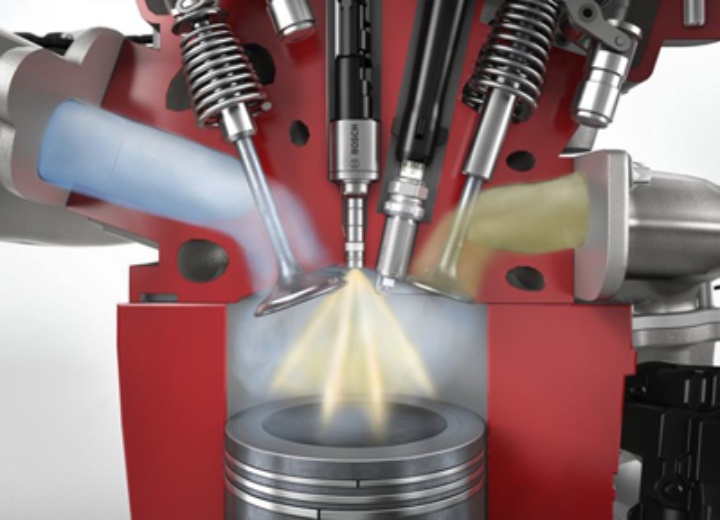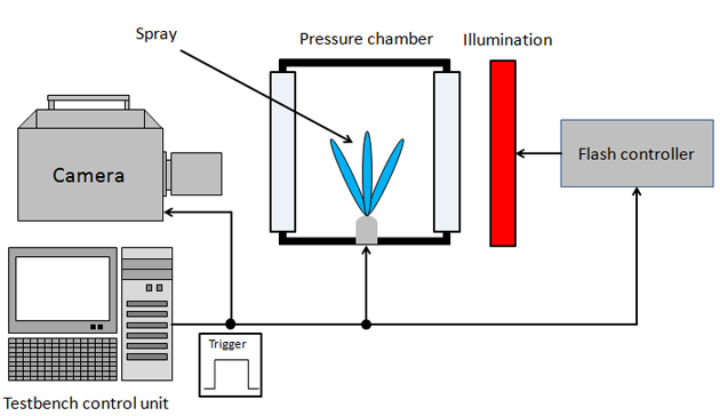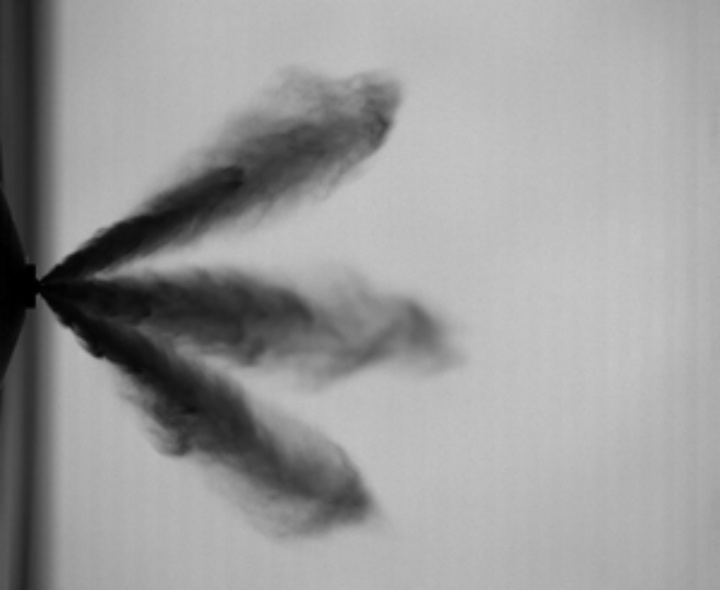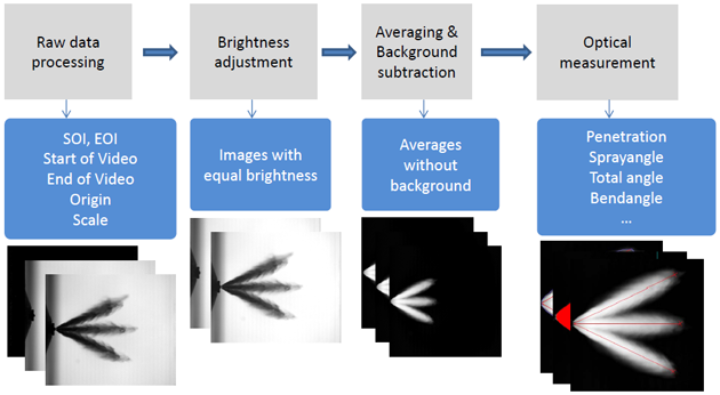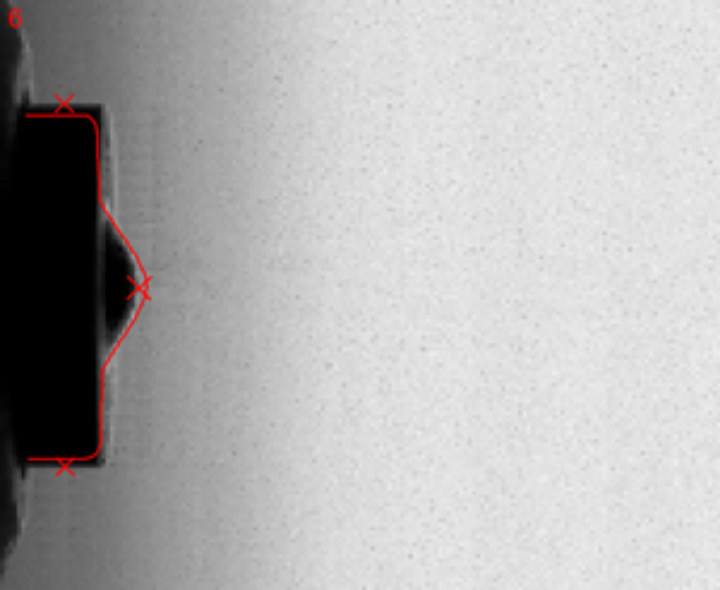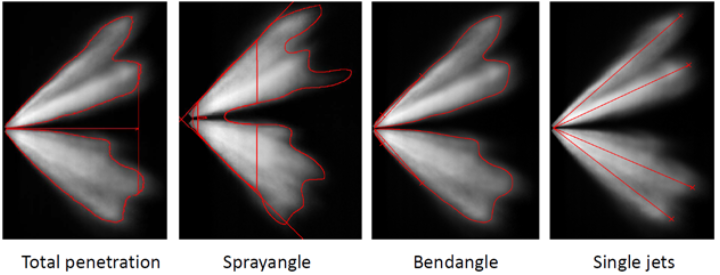Max Paschke (B.Sc. Luft- und Raumfahrttechnik)
Recording & characterization of fuel spray of injectors for gasoline direct injection
Duration: 6 months
Finishing date: June 2015
Examiner: Prof. Dr.-Ing. Dieter Fritsch
Supervising tutor: Helge Dageförde (Robert Bosch GmbH)
Introduction
The increasing need for higher efficiency and reduction of emissions of petrol engines facilitates the need to use gasoline direct injection (DI). Direct injection means that the fuel is injected directly into the combustion chamber. The injection process for a DI system is shown in Figure 1.
The spray behavior of DI injectors is analyzed in this thesis. It is only possible to optimize the DI further by increasing the depth of the investigation of the spray behavior of these injectors. The investigations take place at a testbench for the analysis of injectors. The testbench is already equipped with test equipment for the optical measurement of injectors but this existing equipment and software only allows the examination of injectors under very limited conditions.
In the scope of this thesis the test setup is developed further and the entire injection process is recorded with a high-speed camera. The main task of this thesis is the development and implementation of a routine for the optical evaluation and measurement of these high-speed recordings. The goal of this routine is to be able to characterize the spray behavior of different injectors.
Test setup
In figure 2 the test setup is depicted schematically. The injector is installed into the side wall of a pressure chamber. This pressure chamber allows the user to investigate the spray behavior without the influence of charge motion and combustion. Multiple windows allow easy optical access to the spray. The camera and the illumination device are set up opposed to each other in a shining-through light setup. This results in the injected fuel being detected as a shadow on the camera sensor.
Implementation
The routine starts by processing the raw data. The start and the end of the injection process are detected for each individual injection via a series of thresholding algorithms. In addition to this the tip of the injector is detected with the help of a template-matching algorithm. The precision of the results of this algorithm is further increased with edge detecting algorithms for the detection of the width and exact position of the tip. A result of this detection is displayed in figure 5. The precise width of the tip is used to determine the scale of the pixels in the images.
The next steps are a brightness adjustment and an averaging process with background subtraction. The brightness adjustment is used to balance all images to the same level of brightness which allows the use of much simpler algorithms in the post processing routine. The background detection is used to isolate the spray from the background. Because of the aforementioned inconsistency of the spray an averaging process has to be used. This process compiles multiple images of different injection processes of the same time into one image which then represents the behavior of the spray.
Multiple algorithms for the measurement of the spray are developed to be able to characterize the spray behavior. Example images of the results of these algorithms are displayed in figure 6.
The measurement of the total penetration of the spray allows a description of the depth of penetration of the entire spray into the combustion chamber. The depth of penetration of a spray is dramatically altered with changing Temperature and Pressure.
The sprayangle describes the cone angle of the spray cone in a predetermined interval. This angle is measured by fitting straight lines to the side of the sprayarea. It is possible to describe the spray’s contraction behavior by comparing the measured sprayangle to a reference angle.
The bendangle describes the curvature of the edge of the spray area. In order to measure this variable the spray is intersected with two planes in fixed distance to the injector tip. By measuring the width of the spray in these planes it is possible to calculate the angles. The difference of the measured angles is the bendangle. The bendangle is another criterion for the contraction of the spray.
The measurement of the single jets enables an evaluation of the alignment of the single jets. Furthermore it is possible to evaluate the spray layout. This measurement is only possible in cold operating conditions because only there single jets are visible.
Conclusion
An evaluation routine for the processing and measurement of injection processes of injectors for high-pressure gasoline direct injection has been developed. The injection processes were recorded with a high-speed camera in a shining-through light setup. The processing and measurement of the spray images enables a characterization of the spray behavior of DI injectors. This is an important input variable for the further development of combustion systems.
Ansprechpartner

Norbert Haala
apl. Prof. Dr.-Ing.Stellvertretender Institutsleiter


